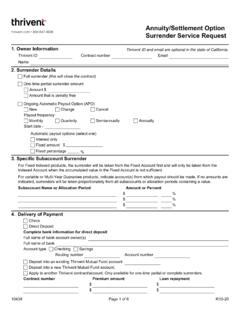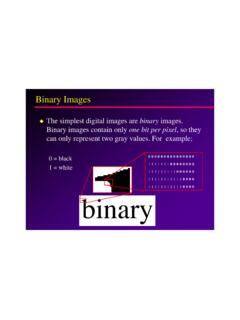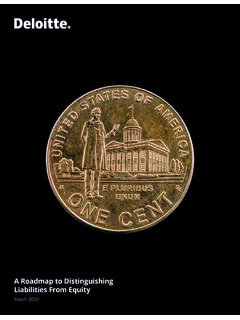Transcription of Social Security: Minimum Benefits - Federation of American ...
1 Social Security: Minimum Benefits Updated June 15, 2021 Congressional Research Service R43615 Congressional Research Service SUMMARY Social Security: Minimum Benefits Social Security s special Minimum benefit provision, also known as the Special Minimum Primary Insurance Amount (PIA), is an alternative benefit formula that increases Benefits paid to workers who had low earnings for many years, and to their dependents and survivors. The Special Minimum PIA is based on the number of years a person has worked with earnings at or above a certain threshold, whereas the regular benefit formula is based on a worker s average lifetime earnings.
2 The worker receives the higher of the two Benefits . In 2019, about 32,092 of the 64 million Social Security recipients qualified for the Minimum benefit. The Special Minimum PIA has virtually no effect on the Benefits paid to today s new retirees. Under current law, it grows with price levels, whereas the regular benefit is linked to wages. Because wages generally grow faster than prices, the Special Minimum PIA affects fewer beneficiaries every year. Beneficiaries who received higher Benefits due to the provision had an average increase to monthly Benefits of about $65 in December 2019.
3 The Social Security Administration (SSA) estimated that the provision would have no effect on workers turning 62 in 2022 or later. Some recent proposals would redesign the Minimum benefit. This renewed interest has been sparked by Social Security proposals that would reduce the regular benefit and by concern over poverty rates among beneficiaries who had low wages throughout their careers. However, some have suggested allowing the Minimum benefit to phase out, arguing that the provision does not accurately target the working poor, and that there are other programs that are more appropriate for supplementing the incomes of low-income, low-asset people.
4 Increases in Social Security Benefits targeted at lifetime low earners could be implemented in various ways. For example, the current Minimum benefit provision could be revised to assist more beneficiaries, the regular benefit could be increased for people who worked for many years at low earnings, or a fixed-dollar benefit could be introduced. Similar provisions could also be introduced through other programs, such as Supplemental Security Income (SSI). R43615 June 15, 2021 Zhe Li Analyst in Social Policy Social Security: Minimum Benefits Congressional Research Service Contents Introduction.
5 1 Determining Regular Social Security Retirement Benefits .. 1 Determining the Special Minimum PIA .. 2 Years of Coverage .. 2 Special Minimum PIA Benefit Amount .. 3 Benefits for Family Members .. 4 Potential Adjustments to the Special Minimum PIA .. 4 Dually Entitled Beneficiaries .. 5 The Special Minimum PIA Has Little Effect on Current Beneficiaries .. 6 History of the Social Security Minimum Benefit Provision .. 8 Original Structure of the Social Security Minimum Benefit (1939 to 1981).. 9 The Special Minimum PIA (1973 to the Present).
6 10 Arguments For and Against a Minimum Benefit Provision .. 11 Arguments for a Minimum Benefit Provision .. 11 Arguments for Phasing Out the Social Security Minimum 13 Considering Minimum Benefit Proposals .. 14 Who Receives the Minimum Benefit Under the Proposal? .. 15 Proposals Based on Years of Work .. 15 Proposals Based on Beneficiary 17 What Is the Minimum Benefit Amount Under the Proposal?.. 17 Benefit Growth: Prices or Wages? .. 18 Partial Benefits : Linear or Nonlinear Proration? .. 18 Interactions Between Social Security Minimum Benefits and Other Government 19 Minimum Benefit Options and Estimated Effects.
7 20 Options Based on Number of Years of Work .. 20 Options to Enhance the Regular Social Security Benefit .. 23 A Fixed-Dollar Benefit .. 24 Alternative Strategies for Addressing Poverty Among Long-Term Low-Wage Workers .. 25 Figures Figure 1. Annual Percentage Change in Average Prices and Wages, 4 Figure 2. Number and Percentage of Social Security Beneficiaries Affected by the Special Minimum PIA .. 7 Figure 3. Number of Families Receiving the Special Minimum PIA, by Year of Benefit Eligibility (May 2020) .. 7 Figure 4.
8 The Regular PIA and the Special Minimum PIA for a Low Earner .. 8 Figure 5. Basic Minimum Benefit 24 Social Security: Minimum Benefits Congressional Research Service Tables Table 1. Special Minimum PIA Initial Monthly Benefit Amounts, 2021 .. 3 Table 2. Illustrative Examples: Workers Earning at and below the YOC Earnings 13 Contacts Author Information .. 26 Social Security: Minimum Benefits Congressional Research Service 1 Introduction Social Security s Minimum benefit provision, the Special Minimum Primary Insurance Amount (PIA), is an alternative benefit formula that increases Benefits paid to workers who had low earnings for many years and to their dependents and survivors.
9 Unlike the regular Social Security benefit formula, which is based on a worker s average lifetime earnings, the Special Minimum PIA is based on the number of years a person has worked with earnings at or above a certain threshold. Beneficiaries receive the higher of the two benefit amounts. Because of the way regular Social Security Benefits and the Special Minimum PIA are computed, the number of recipients who qualify for the Special Minimum PIA has been decreasing. In 2019, about 32,092 (or ) of the 64 million Social Security recipients qualified for the Minimum This report explains how the Special Minimum PIA functions under current law and provides some historical background on Minimum benefit provisions in the Social Security Act.
10 It then presents arguments for and against expanding the Special Minimum PIA, discusses elements to be considered in proposals for change, and describes some specific options for increasing Benefits paid to people with lifetime low earnings or low income. Determining Regular Social Security Retirement Benefits To be eligible for a Social Security retired-worker benefit, a worker generally needs 40 earnings credits (also called quarters of coverage).2 A worker may earn up to four earnings credits per calendar year. In 2021, a worker earns one credit for each $1,470 of covered earnings ( , earnings subject to Social Security payroll taxes),3 up to a maximum of four credits for covered earnings of $5,880 or more.
















